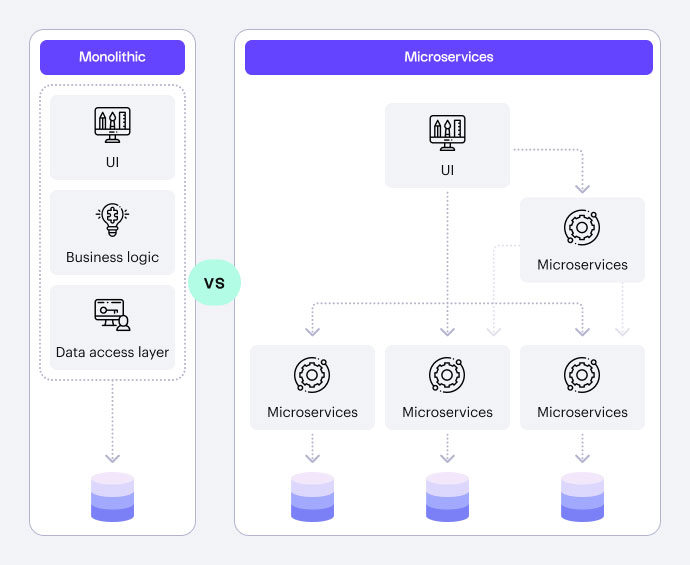
Unless you’ve been living on Mars for the past few years, I’m sure you’ve heard the buzzword “microservices”, also known as microservices architecture.
A distinctive development approach, this natural evolution in software engineering came about due to the ever-increasing complexities of enterprise applications. Traditional applications are usually monolithic in design, which makes them bulky and very difficult to adapt to the changing needs of the business.
Microservices architecture offers to address these problems by splitting up complex software into smaller independent building blocks or services. These modular services can be deployed and managed individually, making large applications more malleable to new requirements.
Today, microservices architecture has been embraced by the industry as an efficient solution to application development and maintenance.
Microservices Architecture, explained

Microservices is an architectural style that logically structures an application as a collection of services. The software is broken down into multiple components that are built as independently replaceable, upgradeable, highly maintainable, and testable services. They are also loosely coupled and can be independently deployed. Microservices are often organized around business capabilities.
Because microservices architecture is structured as a set of loosely coupled, collaborating services, this approach allows for designing highly flexible, scalable, and available enterprise systems and applications. It facilitates rapid application development and delivery, plus enables a scalable and evolving technology stack.
In terms of microservice architecture design, there are different approaches: request-driven microservices, in which the different services communicate through a synchronous request-response pattern; event-driven microservices which facilitates independent and asynchronous computing; and hybrid architecture, which employs a mixture of both approaches.
9 benefits of microservice-oriented applications
From decentralized governance to resiliency, there are many advantages of adopting the Microservices Architecture style in software and application development.
1. Application is more accessible
As mentioned above, the microservices architecture is modular in design. This helps the users of the API better understand the type of services offered.
2. It’s easier to find bugs
When implemented correctly, microservices makes finding and isolating bugs much easier. Whenever an errors occurs, developers will know exactly where to look, which saves valuable time and effort. What’s more, the modular approach allows for failure isolation—other independent components of the application won’t be affected, and there would be no need to deploy the entire application after fixes.
3. Application is easier to maintain
The microservices architecture design allows for easier maintenance and management of the individual components. Since each service has its own code and database, it can be managed independently by a different team. Redeployment can be performed without affecting the whole system.
4. Each service is autonomous
Microservices are loosely coupled and have a standardized way of communicating with each other. Because of the modular design, the different services often use different programming languages or technology. This means that each service can be uniquely designed based on the required functions.
5. Application can easily evolve and adapt
Business requirements for applications are ever changing and evolving. There will always be a need to add new features or incorporate new technology. In the traditional architecture approach, updates often mean changing the entire business logic and potentially introducing errors. Microservices architecture, with its independent component, doesn’t have this problem.
6. Application can easily scale
This is one of the main benefits of microservices: its ability to scale horizontally. This means that any deployed service can be duplicated in order to avoid slow execution bottlenecks. Another option to increase performance is to run the service on more powerful hardware or multiple machines that can process data in parallel.
7. Testing and security monitoring are more manageable
Single software components are much easier to test than a complex application. The application is likely to be more robust if each individual component is tested properly. What’s more, the ability to isolate each service facilitates better security management and monitoring—it’s easier to isolate threats with the modular arrangement.
8. Operational complexity is reduced
Microservices have become much easier to develop, deploy, and test over the years due to various factors: technological developments such as cloud computing, drastic improvements in infrastructure automation techniques, and the principle of continuous delivery through DevOps.
9. Components can be reused
An often forgotten but great benefit of microservices is the fact that the independent components that make up the entirety of the software can be reused for future projects. By reusing successful processes and only modifying them as needed, development teams wouldn’t need to reinvent the wheel every time—consuming fewer resources.
Final thoughts
Modern systems are moving towards microservices architecture for obvious reasons. The advantages of decoupling systems allow companies to be able to scale and grow with the ever-changing business landscape. Scalability is affordable with cloud technologies, and many companies need to take advantage of this in order to move forward—or otherwise be left behind.
Having said that, it’s important to remember that transitioning over to microservices must be well thought out, because success can only be achieved from a system that is so loosely coupled and where all the pieces work with the same heartbeat.





